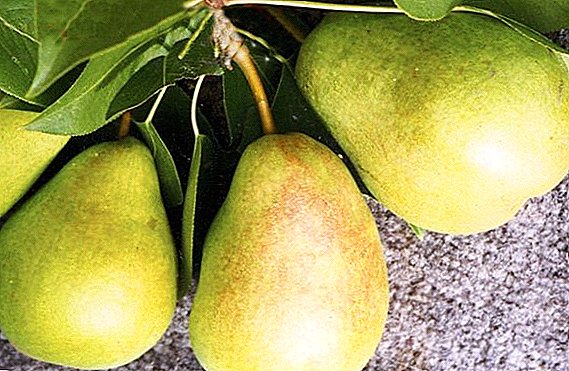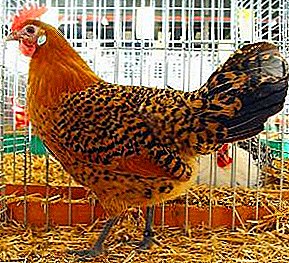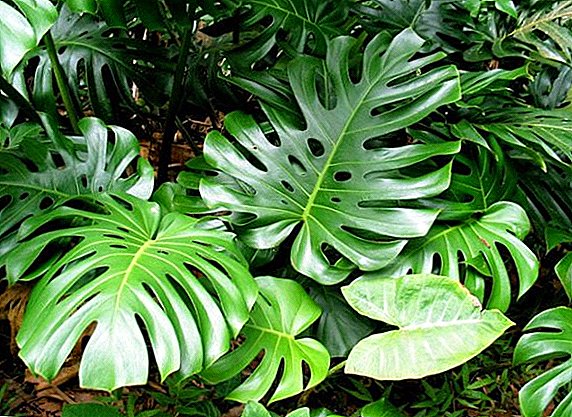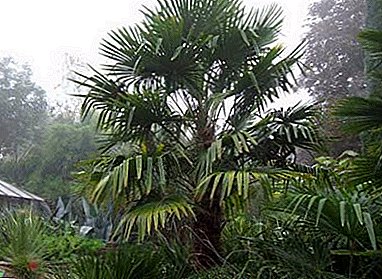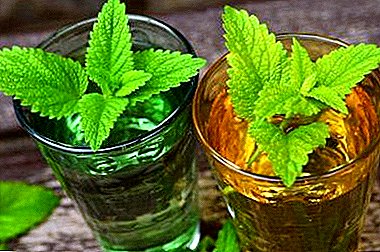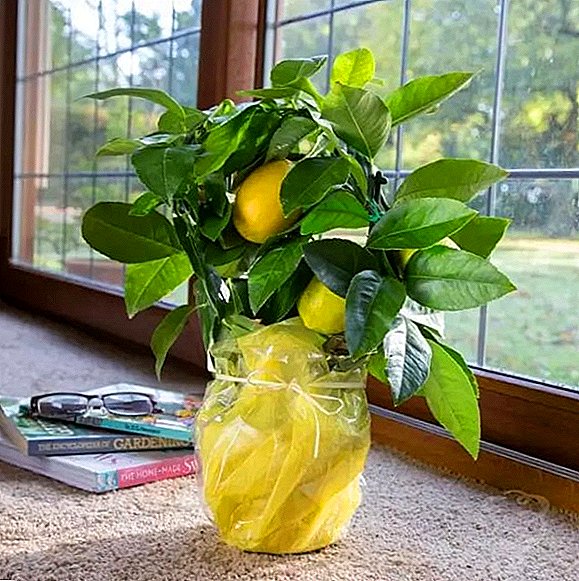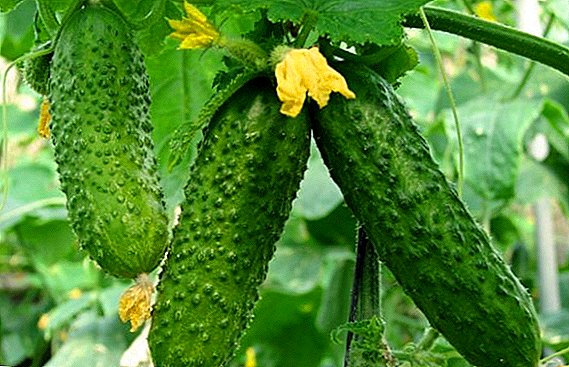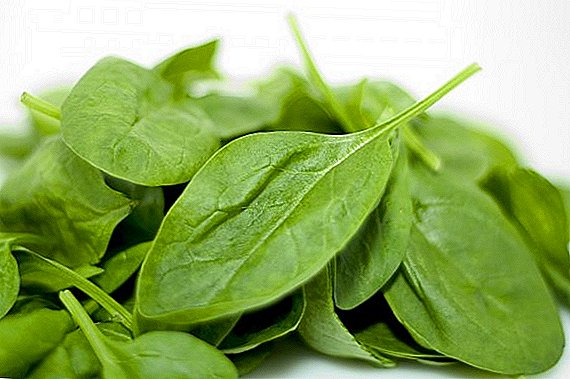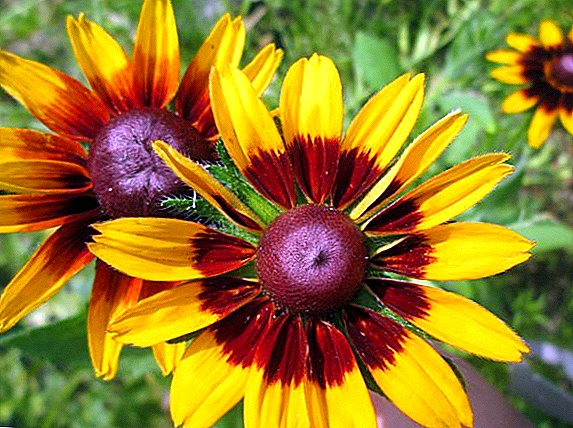 Rudbeckia - annual, biennial or perennial herbaceous plants belonging to the Aster or Compound family. In total there are about 40 types of rudbeckia. Natural habitat - North America, common in Europe and Africa. The first name is Suzanne's black eyes.
Rudbeckia - annual, biennial or perennial herbaceous plants belonging to the Aster or Compound family. In total there are about 40 types of rudbeckia. Natural habitat - North America, common in Europe and Africa. The first name is Suzanne's black eyes.
Did you know? The modern scientific name was given by Karl Linney in honor of the Swedish botanists - the father and son Rudbekov.
Perennial species of rudbeckia
The most common in culture, have good resistance to temperature and disease. We offer to get acquainted with the most popular types of perennial rudbeckia.
Rudbeckia brilliant (radiant)
Frost-resistant perennial plant with straight stems, elongated, narrowed leaves, flowers up to 9 cm in diameter, which are created from red and orange flowers and collected in star-shaped inflorescences. 
Brilliant rudbeckia - the plant is miniature, its height is only 60 cm. One of the varieties of rudbeckia is brilliant - rudbeckia variabilis, whose flowers are yellow-orange and bright, and in the middle - scarlet. Goldstar and Goldsturm varieties are also widespread with golden flowers and a pronounced brown center.
Flowering lasts from June to October. He likes sunny places, grows well on nutrient drained soils, and tolerates drought poorly. Also, Rudbeckia needs mineral fertilizer, regular disposal of weeds, removal of dried leaves and dried flowers, and pruning for the winter to the ground. Propagated by division or seed.
Important! Low-growing varieties of rudbeckia can be grown in tubs on balconies and terraces, then flowering will last the whole summer and end in mid-September.
Giant rudbeckia
The distribution area is North America. Large architectural perennial with bluish-green leaves, covered with a wax coating, bright yellow reed flowers, with dark tubular petals that form the original oblong cones. The height of giant rudbeckia is 120-150 cm. 
Blooms in late July, blooms until early September. The plant is frost-resistant and rather drought-resistant, the best place for giant rudbeckia - with direct sunlight or partial shade. After flowering, flower stalks should be trimmed to give the plant a neater look. The advantage is that the plant is well worth the cut. Also giant rudbeckia looks great in the garden.
Western Rudbeckia
Perennial drought-resistant herb, reaching a height of 1.5 m. In its inflorescences there are no reed flowers, orebeckia flowers are cone-shaped or cone-shaped, surrounded by green leaves, bracts. 
This species was introduced into culture in 2002. In the garden market you can find only two varieties - this is the Green Wizard (Green Wizard) and Black Beauty (Black Beauty). The flowering period of western Rudbeckia is from mid-June to September.
This variety is suitable for creating single and group plantings on the lawn, decorating fences, porches, gazebos and other garden and architectural structures. Also, the plant can be used to compose live bouquets.
Western Rudbeckia is light-requiring, it should be grown in sunny areas, closed from cold winds; the best soils are fertilized, moderately moistened loam, but can grow and develop on sandy and acid-rich soils that have been preliminated.
Propagation of Western Rudbeckia occurs by seed or seedling. Seed collection takes place in the fall, they are dried, packed in paper bags and stored in a dry warm place. Planting seedlings on a permanent place takes place in early June.
Western Rudbeckia needs rare irrigation with settled water, regular weeding, loosening the soil, feeding with complex fertilizers. Extension of flowering inflorescences will help to prolong flowering.
Beautiful rudbeckia
Rudbeckia beautiful is often used by gardeners, the birthplace of the species is North America. Herbaceous perennial 60 cm tall, with strong stems and oblong or rounded leaves; inflorescences-baskets in diameter up to 10 cm, which consist of black-brown tubular and yellow-orange reed flowers. Feature reed flowers - three cloves, located at the tips of the limb. 
The flowering of beautiful rudbeckia lasts from the first decade of July to the beginning of September. It is characterized by winter hardiness, endurance to pests and diseases, rarely affects nematodes, because of which flowers fade.
Popularly, this variety is called the "golden umbrella". It is better to choose for fertilizer beautiful fertilized, unsalted, loose soil, and a sunny location or partial shade. It is worthwhile to carry out timely morning or evening watering, divide every 3-4 years, feed with sodium and magnesium every three weeks, get rid of weeds and loosen the soil.
Breeding Rudbeckia beautiful seeds and dividing the bush. Seeds are sown in open soil in early March.
Rudbeckia hybrid
Perennial 1.2 m high, with strong, strongly branchy, densely leafy stems that are pubescent with stiff hairs along the entire length; with ovate and oval leaves, also pubescent; inflorescences in the form of baskets, in a diameter of 20-25 cm, which are formed from brown-yellow reed flowers and brown-purple tubular. 
The fruits of hybrid rudbeckia are brilliant seeds 30 mm long. Rudbeckia hybrid creates powerful bushes covered with large baskets.
The most popular varieties among gardeners - Amber (drought-resistant and frost-resistant perennial with brown and scarlet inflorescences); Bright autumn (used for decoration of flower beds, with rough stems and purple-brown baskets); Gloriosa Desi (perennial with large baskets in diameter up to 16 cm); Double Desi (perennial with rough, strong-branched stems, studded with pubescent oval and ovate leaves); Golden storm (universal variety, suitable for creating mixborders, flower beds, combined with many flower cultures).
For the cultivation of hybrid Rudbeckia fit sunny areas with moist loose soils, the plant needs to be fed twice a season, the garter of stems, removal of flowering inflorescences and cutting in the fall. Watering is needed during a drought.
Also among the perennials can be distinguished glossy orebeck. Tall and powerful plant with very large yellow umbellate inflorescences. Since the plant Rudbeckia is glossy, rather unpretentious and resistant to external factors, it is easy to answer the question where it grows - almost all over Europe and America, but most often it prefers damp shady places in eastern North America.
Another perennial variety is the Golden Ball. Tall herb (2-2.5 m), with bright green, strongly dissected leaves. The inflorescences of the basket consist of double filled globular flowers. The perennial has two significant drawbacks. High shoots are falling apart in different directions, as well as the golden ball Rudbeckia tends to grow strongly, preventing other plants in the flower bed.
Annual Types of Rudbeckia
Rudbeckia has not only perennial, but also annual varieties that are easy to care for and which are nice to look at.
Hairy rudbeckia (hirt)
Most often, hairy rudbeckia is grown as an annual: in the first year, its flowering is most spectacular, over the years its attractiveness is lost. The plant has straight pubescent stems with developed branches 0.5-0.9 m in height. The upper leaves are sessile, lanceolate, the lower ones are large (up to 13 cm in length) and with a winged petiole. Inflorescences are single baskets with a diameter of 5 to 15 cm, reed flowers are yellow-brown in color, tubular ones are black-brown. 
The most commonly used variety is Toto. Rudbeckia Toto is a short, tiny annual with large, attractive buds on compact branching stems. As well as for other types of rudbeckia, a well-lit place will suit her, the best soils are light, permeable loams. Reproduction occurs by seed and division of the bush. Sow the plant in late May. Flowering begins in July and lasts until September.
Did you know? From hairy orebeckia they produce homeopathic medicines that have a positive effect on chronic fatigue syndrome, prostatitis and inflammation of the uterus, tonsillitis and coughing.
Rudbeckia bicolor
One of the most popular types of annual rudbeckia, which in the process of growth creates sprawling bushes. The inflorescences of the plant can be very different forms. 
Usually pale yellow with a brown pattern on the petals. It has an abundant bloom that lasts from the second half of July to the beginning of October. It prefers well-lit places or light penumbra, but full shadow is very detrimental to the condition of the leaves of two-color Rudbeckia.
It grows best on loamy, loose, moist soils. Hybrid varieties are larger in size, have a longer flowering period than wild.
Important! The best neighbors of a two-color rudbeckia in a flower bed will be phlox, delphinium, aster and lupine. Thanks to the merging of colors of flowers, the flower bed gets an aesthetic and well-groomed appearance.
Rudbeckia covering
Annual, reaching a height of 80 cm. Stems pubescent and dense. The leaves of Rudbeckia embracing are placed opposite, bare, sessile, oval or elongated, with a pointed apex and thin denticles along the edge. 
The inflorescences are collected in baskets, reed flowers of a bright yellow shade, tubular - dark brown flowers, on a receptacle towering 3 cm. Often used in landscape design when creating mixborders.
Rudbeckia triloba
Herbaceous annual, height varies from 60 cm to 1.5 m. Numerous stems branch strongly at the base, strong and hairy, leaves 12 cm long, oblong or ovate, tapering to the base into a winged petiole, bright green, slightly pubescent or bare . 
Multiple baskets 3-4 cm in diameter, reed flowers - yellow or orange, elliptical and shiny, 2 cm long, tubular have a black and scarlet color. Flowering later - from August to October. It has good frost resistance, can withstand up to -29 ° C. He entered the culture in 1699.
Growing orebecky will not cause much trouble and will not require special financial costs from gardeners. Suzanne's beautiful black eyes will delight and touch the owners with their flowering.


